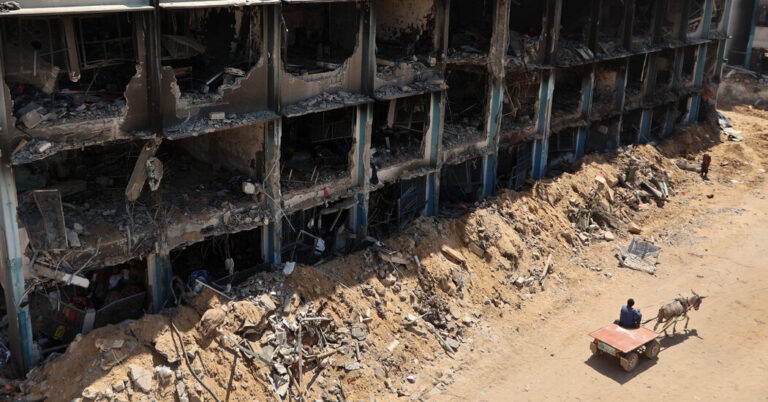Residents who returned to the northern Gaza town of Jabaliya on Friday expected massive devastation, but said they were still shocked by the level of ruin they saw after three weeks of an Israeli offensive there. dense urban area.
“The destruction is indescribable,” said Mohammad Awais, who returned with his family to their home in Jabaliya on Friday. “Our minds are not capable of understanding what we see.”
He said he and his family walked along devastated roads for nearly an hour in the heat and found that no vehicles could move through streets blocked by piles of rubble from homes and shops destroyed by the Israeli army.
As they walked, rescue workers passed by, carrying the injured and the bodies of those killed on stretchers. Some bodies were found in the streets, others had been pulled from the rubble – already beginning to decompose, said Mr Awais, a social media marketer.
“Even ambulances cannot cross them to transport the injured and martyrs,” he said of Jabaliya’s streets.
The Israeli army announced Friday that it had completed its offensive in eastern Jabaliya and had withdrawn after recovering the bodies of seven hostages, killing hundreds of fighters and destroying several kilometers of a network of underground tunnels.
Satellite images captured at the end of May by Planet Labs showed the extent of the destruction in a southern area of the city and in the area near the market.


Some buildings had already been destroyed before the latest Israeli offensive in the region, according to images from April. But by late May, many more structures in these areas appeared flattened and almost all vegetation had been razed.
Mr. Awais and his family are among the few residents who still have a place to return to. Their house was only partially damaged. On Friday, they began cleaning up parts of collapsed walls, pieces of wood and glass and ruined furniture so that their house becomes habitable again. But the family supermarket, which had to close its doors in December because of Israel’s siege of Gaza, was completely destroyed, he said.
“The rubble is everywhere,” he added.
On May 11, the Israeli army announced that it had renewed its offensive in Jabaliya because Hamas, the Palestinian armed group that led the October 7 attack, was trying to rebuild its infrastructure and operations in the area. At the time, Hamas accused Israel of “intensifying its aggression against civilians throughout the Gaza Strip” and vowed to continue fighting.
Israel invaded northern Gaza for the first time after weeks of carrying out an intense air attack on the enclave following the October 7 attack. The army launched numerous deadly attacks against Jabaliya. Having survived the onslaught in the first months of the war, many residents of Jabaliya believed they were safe from a new Israeli offensive.
“The residents returned with tears in their eyes,” said Hossam Shbat, a journalist in Gaza. “All we see is rubble, destruction and wreckage. And more massacres.
He added: “Residents returned to see what no one can imagine: the destruction of businesses, infrastructure and shelters that housed thousands of displaced people. »
Jabaliya is often referred to as a camp because it was established more than 70 years ago by Palestinian refugees who were expelled or forced to flee their homes in present-day Israel during the creation of the state. They were never allowed to return home and Jabaliya became a community populated by refugees and their descendants.
In a video Mr. Shbat recorded on Thursday, showing the ruins of Jabaliya around him. Behind him, in the shell of a four-story building, fires were still smoldering in the rubble.
“We can’t describe it in words,” he said in an interview. “The occupying army has intentionally destroyed all the essential elements of life. »


